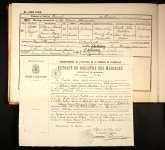Taphrospilus
Well-known member
Dissura mortoni Ogilvie-Grant, 1902 OD here
The Eponym Dictionary of Birds claims:
The Key to Scientific Names
Maybe we get his life dates here?
The Eponym Dictionary of Birds claims:
Stork sp. Dissura mortoni Ogilvie-Grant, 1902 NCR [Alt. Storm's Stork; JS Ciconia stormi]
William Morton (DNF) was a British civil servant in Sarawak. In his etymology Ogilvie-Grant wrote: 'A Stork belonging to the genus Dissoura was recently shot by Mr William Morton on the Simunjan River, a tributary of the Sadong, in Southern Sarawak, and subsequently brought to me for identification. An examination of the series of Dissura episcopus in the British Museum confirmed the suspicion that this bird belonged to a perfectly distinct species, but disclosed the fact that a similar specimen to that shot by Mr Morton had been sent home by Sir Hugh Low in 1876. Probably from lack of material the differences between this bird and D. episcopus had not been recognised, and the specimen had been catalogued under the latter title'. Ogilvie-Grant was right in saying the stork was distinct from Ciconia episcopus (Woolly-necked Stork), but Blasius (q.v.) had already named the taxon (1896).
The Key to Scientific Names
William Morton (fl. 1902) British civil servant in Sarawak, collector (syn. Ciconia stormi).
Maybe we get his life dates here?





